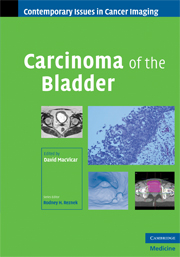Book contents
- Frontmatter
- Contents
- Contributors
- Series foreword
- Preface to Carcinoma of the Bladder
- 1 The pathology of bladder cancer
- 2 Clinical features of bladder cancer
- 3 Imaging in the diagnosis of bladder cancer
- 4 Radiological staging of primary bladder cancer
- 5 Imaging of metastatic bladder cancer
- 6 Surgery for bladder cancer
- 7 External beam radiotherapy for the treatment of muscle invasive bladder cancer
- 8 The chemotherapeutic management of bladder cancer
- 9 Clinical follow-up of bladder cancer
- 10 Imaging of treated bladder cancer
- Index
- Plate section
- References
7 - External beam radiotherapy for the treatment of muscle invasive bladder cancer
Published online by Cambridge University Press: 25 August 2009
- Frontmatter
- Contents
- Contributors
- Series foreword
- Preface to Carcinoma of the Bladder
- 1 The pathology of bladder cancer
- 2 Clinical features of bladder cancer
- 3 Imaging in the diagnosis of bladder cancer
- 4 Radiological staging of primary bladder cancer
- 5 Imaging of metastatic bladder cancer
- 6 Surgery for bladder cancer
- 7 External beam radiotherapy for the treatment of muscle invasive bladder cancer
- 8 The chemotherapeutic management of bladder cancer
- 9 Clinical follow-up of bladder cancer
- 10 Imaging of treated bladder cancer
- Index
- Plate section
- References
Summary
Introduction
Options for the radical treatment of muscle invasive bladder cancer have traditionally been radical cystectomy or external beam radiotherapy. For many, cystectomy has been the preferred option, with radiotherapy given for medically inoperable cases [1]. Although no randomized comparison of the two treatments exists, outcomes with radiotherapy have historically been seen to be inferior [2–4]. This may have been owing to negative case selection, i.e. cases given radiotherapy being medically less fit or with poorer prognosis, and issues with stage migration in the comparison of clinically versus pathologically staged patients. More recent series, combining advances in systemic therapy and radiotherapy treatment planning and delivery, suggest comparable results to cystectomy [5–10]. The concept of selective bladder preservation is now gaining appeal, whereby radical treatment options are determined by the tumor response to neoadjuvant chemotherapy. As a result, more patients are undergoing radical radiotherapy and organ preservation.
Radiotherapy as a radical treatment for bladder cancer involves the delivery of a dose (“fraction”) of high-energy X-rays (usually with peak voltage of 6–10 MV) to the target region of the bladder. This is repeated daily for four to six weeks to achieve a tumouricidal dose of radiation to the tumor itself while sparing surrounding normal tissue. The delivery of radiotherapy is technically demanding because of day-to-day variations in bladder filling, resulting in changes in bladder size and position, which must be accounted for to avoid geographic miss.
- Type
- Chapter
- Information
- Carcinoma of the Bladder , pp. 106 - 124Publisher: Cambridge University PressPrint publication year: 2008

